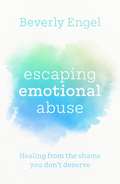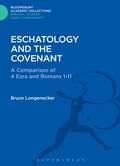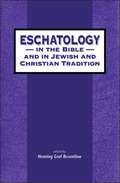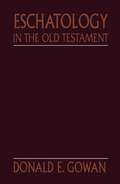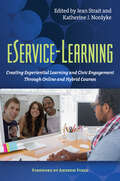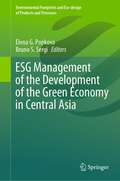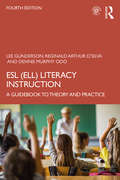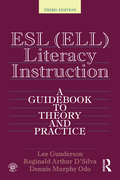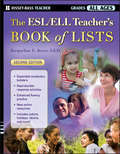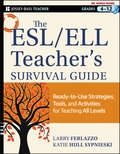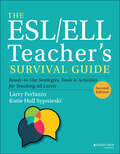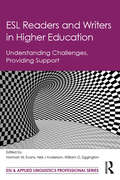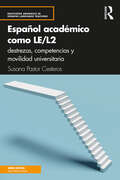- Table View
- List View
Erziehungsziel Mehrsprachigkeit: Eine qualitative Studie zu Erziehung und Elternschaft im Kontext von Migration (Inklusion und Bildung in Migrationsgesellschaften)
by Yasemin UçanIn der Studie wird die Erziehung zur frühkindlichen Mehrsprachigkeit in Familien aus der Türkei untersucht. Anhand von mehrsprachigen qualitativen Interviews mit Müttern und Vätern, differenziert nach Geschlecht, Migrationsgeneration und Schulbildung, werden Erziehungsvorstellungen, familiäre Aushandlungen sowie Erwartungen an Einrichtungen der Frühpädagogik diesbezüglich herausgearbeitet. Als ein wichtiges Ergebnis ist festzuhalten, dass die elterliche Erziehung zur Mehrsprachigkeit in komplexe Planungs- und Reflexionsprozesse eingebettet ist und sich durch ein hohes Maß an (unsichtbarer) Erziehungsarbeit auszeichnet. Gleichzeitig sind vielfache Spannungen festzuhalten, die sich aus normativ gerahmten Erziehungsvorstellungen sowie der konkreten migrations- und minderheitenspezifischen Lebenslage und familiären Dynamiken ergeben.
Erziehungsziel "Selbstständigkeit": Grundlagen, Theorien und Probleme eines Leitbildes der Pädagogik
by Elmar DrieschnerDas Erziehungs- und Bildungsverständnis heutiger Eltern und Pädagogen ist zentral durch den Gedanken der Förderung der Selbstständigkeit von Kindern und Jugendlichen bestimmt. Die theoretischen Hintergründe dieses Erziehungsziels sind bereits seit der pädagogischen Aufforderung zur Selbsttätigkeit und Autonomie in der Aufklärung ein Schlüsselthema pädagogischer Reflexion. Seither wird das Konstrukt Selbstständigkeit in verschiedenen Theorien und Teildisziplinen der Erziehungswissenschaft diskutiert. In einer historisch-systematischen Zusammenschau beleuchtet Elmar Drieschner klassische und aktuelle Perspektiven auf Selbstständigkeit. Der Autor thematisiert das Verhältnis der verschiedenen theoretischen Zugänge, problematisiert Selbstständigkeitsbilder neuerer Kindheits-, Erziehungs- und Bildungstheorien und schafft so einen strukturierten Überblick in der Vielfalt des erziehungswissenschaftlichen Diskurses.
Es hielt uns am Leben: Humor im Holocaust
by Chaya Ostrower Miriam YusufiDieses Buch „Es hielt uns am Leben. Humor im Holocaust“ bietet eine positive Antwort auf die Frage, wie Humor bei der Bewältigung der schrecklichen Realität geholfen hat. Interviews mit Überlebenden beschreiben schreckliche Ereignisse, die mit makaberem Humor verwoben sind. Humor während des Holocaust verminderte nicht die objektiven Erfahrungen, sondern linderte die emotionale Reaktion auf die Schrecken. Humor und Lachen können helfen, die mentale und körperliche Gesundheit zu stärken, zu heilen und zu erhalten, kann aber Menschen helfen, mit einem Trauma umzugehen, dessen Auswirkungen so schwerwiegend sind wie der Holocaust? Chaya Ostrower klassifiziert die Arten von Humor und Witze und studiert ihre jeweiligen Funktionen in den Ghettos, Konzentrationslager und Todeslager. Enthalten in dem Buch sind humorvolle Ditties, Songs und Kabarett Skizzen, sowie die einzigartige Geschichte von zwei Ghetto-Clowns.Überlebende wussten immer um die Existenz von Lachen und Humor während des Holocaust. Die Jahrzehnte, die seit der Befreiung vergangen sind, geben uns nun die Möglichkeit, dieses sensible Thema mit Abstand zu betrachten.
Escaping Emotional Abuse: Healing from the shame you don’t deserve
by Beverly EngelDoes your partner blame you for his or her own problems?Does your partner humiliate you, especially in front of others?Is your partner impossible to please?Are you convinced something is wrong with you?Are you too ashamed to admit you are being abused?In Escaping Emotional Abuse, Beverly Engel, world-renowned therapist and expert in emotional abuse, exposes techniques an abuser uses to break your spirit and gain control - and guides you in how to free yourself from the shame that can keep you from the life, and the love, that you deserve.By using your deepest fears against you, the abuser strips you of self-esteem, dignity, and humanity - making you feel unworthy and utterly powerless to escape. But you possess a potent tool with which to combat shame: self-compassion. In these pages, Engel shows you how to access it. Using her highly effective Shame Reduction Program, she helps you jumpstart the process of recovery by offering specific steps to help you heal and regain self-confidence.An invaluable resource for both men and women who suffer from emotional abuse, as well as therapists and advocates, Escaping Emotional Abuse is a supportive, nurturing guide for anyone seeking to break the chains of shame, and gain the emotional freedom to create healthier, lasting relationships.
Eschatology and Space: The Lost Dimension in Theology Past and Present
by V. WesthelleThis unique volume focuses on the subjects of time in the area of theology known as 'eschatology,' the consideration of the fullness, the limit, and the goal of time. He traces the historical development of understandings of eschatology from the Bible to contemporary theology and adds a postcolonial/subaltern perspective.
Eschatology and the Covenant: A Comparison of 4 Ezra and Romans 1-11 (The Library of New Testament Studies)
by Bruce LongeneckerThis extensive and detailed analysis compares Paul with the author of 4 Ezra against the background of Sanders's portrayal of early Judaism. 4 Ezra and Paul would seem to have one significant point in common: their common displacement from the covenantal 'pattern of religion' which was so prevalent in Early Judaism. It is from this perspective that Longenecker undertakes his comparison.
Eschatology in the Bible and in Jewish and Christian Tradition (The Library of Hebrew Bible/Old Testament Studies)
by Henning Graf ReventlowThis is the fourth volume in the series of collaborations between the Department of Bible in Tel Aviv University, Israel, and the Faculty of Theology in the University of the Ruhr, Bochum, Germany. This symposium, held in Bochum in 1995, discussed a topic important for both communities of believers, starting with the Bible and tracking its role through the different stages of the respective tradition-histories. This time the theme was eschatology. The participants engaged in a lively discussion (from the Jewish side) on messianism and Zionism, Qumran, Mishnah and Kabbalah, and (from the Christian side) on the Bible, recent Protestant ethics and systematic theology. The volume concludes with the report of a panel discussion on the essence of eschatology in Jewish and Christian thinking: is it a spiritualized idea or a material expectation for the world?
Eschatology in the Old Testament
by Donald GowanUsing a canonical approach, in which he explores the Old Testament as a whole - rather than the teachings of individual Old Testament authors - Professor Gowan traces the hopes of the people of Israel for a better future. He concludes that for God to make things right, a three-fold transformation of the world must take place: God must transform the human person, human society, and nature itself. This is a modern, comprehensive introduction to eschatology in the Old Testament, and includes a new introduction.
eService-Learning: Creating Experiential Learning and Civic Engagement Through Online and Hybrid Courses
by Jean Strait Katherine J. NordykeThis book serves as an introduction to using online teaching technologies and hybrid forms of teaching for experiential learning and civic engagement. Service-learning has kept pace neither with the rapid growth in e-learning in all its forms nor with the reality that an increasing number of students are learning online without exposure to the benefits of this powerful pedagogy.Eservice-learning (electronic service-learning) combines service-learning and on-line learning and enables the delivery of the instruction and/or the service to occur partially or fully online. Eservice-learning allows students anywhere, regardless of geography, physical constraints, work schedule, or other access limitations, to experience service-learning. It reciprocally also equips online learning with a powerful tool for engaging students.In eservice-learning, the core components of service, learning, and reflection may take a different form due to the online medium—for example, reflection often occurs through discussion board interactions, journals, wikis, or blogs in an eservice-learning course. Moreover, the service, though still community-based, creates a world of opportunities to connect students with communities across the globe—as well as at their very own doorstep.This book introduces the reader to the four emerging types of eservice-learning, from Extreme EService-Learning (XE-SL) classes where 100% of the instruction and 100% of the service occur online, to three distinct forms of hybrid where either the service or the instruction are delivered wholly on-line – with students, for instance, providing online products for far-away community partners – or in which both are delivered on-site and online. It considers the instructional potential of common mobile technologies – phones, tablets and mobile reading devices. The authors also address potential limitations, such as technology challenges, difficulties sustaining three-way communication among the instructor, community partner, and students, and added workload.The book includes research studies on effectiveness as well as examples of practice such drafting grants for a community partner, an informational technology class building online communities for an autism group, and an online education class providing virtual mentoring to at-risk students in New Orleans from across the country.
eService-Learning: Creating Experiential Learning and Civic Engagement Through Online and Hybrid Courses
This book serves as an introduction to using online teaching technologies and hybrid forms of teaching for experiential learning and civic engagement. Service-learning has kept pace neither with the rapid growth in e-learning in all its forms nor with the reality that an increasing number of students are learning online without exposure to the benefits of this powerful pedagogy.Eservice-learning (electronic service-learning) combines service-learning and on-line learning and enables the delivery of the instruction and/or the service to occur partially or fully online. Eservice-learning allows students anywhere, regardless of geography, physical constraints, work schedule, or other access limitations, to experience service-learning. It reciprocally also equips online learning with a powerful tool for engaging students.In eservice-learning, the core components of service, learning, and reflection may take a different form due to the online medium—for example, reflection often occurs through discussion board interactions, journals, wikis, or blogs in an eservice-learning course. Moreover, the service, though still community-based, creates a world of opportunities to connect students with communities across the globe—as well as at their very own doorstep.This book introduces the reader to the four emerging types of eservice-learning, from Extreme EService-Learning (XE-SL) classes where 100% of the instruction and 100% of the service occur online, to three distinct forms of hybrid where either the service or the instruction are delivered wholly on-line – with students, for instance, providing online products for far-away community partners – or in which both are delivered on-site and online. It considers the instructional potential of common mobile technologies – phones, tablets and mobile reading devices. The authors also address potential limitations, such as technology challenges, difficulties sustaining three-way communication among the instructor, community partner, and students, and added workload.The book includes research studies on effectiveness as well as examples of practice such drafting grants for a community partner, an informational technology class building online communities for an autism group, and an online education class providing virtual mentoring to at-risk students in New Orleans from across the country.
The ESG and Sustainability Deskbook for Business: A Guide to Policy, Regulation, and Practice
by Kristyn NoethThe interest in sustainability and environmental, social, and governance (ESG) from stakeholders across all sectors is growing and will continue to do so as we are in the most pivotal decade for meeting the global goals on climate change and sustainable development. This book is a compendium of the international agreements, regulatory advancements, and current practicum to inform a 360-degree viewpoint of the organizations, frameworks, and stakeholders that shape the evolving landscape.Written in a straightforward and conversational tone, you’ll embark on a knowledge journey on the progression of ESG and sustainability and how it directly shapes and informs current practice. It provides insights, discussion, and topical briefings as a side-by-side reader to accompany the rise of ESG and sustainability in business and the markets. The flow of information and reader education begins with the origins of sustainability in international treaties and policy. It then moves on to theadvent and differentiation of ESG, sustainability, and social responsibility; provides substantive issue briefings on the key “E,” “S,” and “G” factors. You’ll continue by walking through the global regulatory and standards paradigms; delve into ESG ratings and indices; and examine in-depth analysis of the respective roles of the corporation, the financial and investment sector, the international bodies, the business interest groups, the NGOs and third-party organizations, and the philanthropic community. You’ll also see that corporations and investors are advancing ESG and sustainability strategies and programs at a record pace. What were once regarded as “nice-to-have” initiatives with voluntary reporting have moved into the regulated sphere with mandatory public disclosures and reporting requirements on greenhouse gas emissions, climate risk and transition planning, biodiversity and nature-related impacts, supply chain transparency, anti-bribery and corruption, humanrights, human capital, and board diversity. The ESG and Sustainability Deskbook for Business threads the needle with best practices, case studies, and takeaways to illustrate the applications and to enhance understanding.What You Will LearnStudy the progression of ESG and sustainability and how related considerations increasingly drive business, policy, and economic decisionsReview Takeaways and best practices to provide insights and discussion pointsUnderstand the critical differences between ESG, social responsibility, and sustainabilityWho This Book is ForESG and Sustainability Practitioners (across all sectors), Corporate leadership, Tech sector (a key growth area for compliance, reporting, and GHG accounting), Investors, Compliance, risk, legal, and corporate governance professionals, Management and board consultants
ESG Management of the Development of the Green Economy in Central Asia (Environmental Footprints and Eco-design of Products and Processes)
by Elena G. Popkova Bruno S. SergiThis book proposes digitalization as a promising direction for green growth and sustainable development of the economy of Central Asia. It reveals the advanced and unique hands-on and case-based experience of Central Asia in ESG management with the involvement of digital technologies and provides practical recommendations on the extension of the use of digital technologies in ESG management of the development of the green economy in Central Asia.
ESL (ELL) Literacy Instruction: A Guidebook to Theory and Practice
by Lee Gunderson Reginald Arthur D'Silva Dennis Murphy OdoNow in its fourth edition, ESL (ELL) Literacy Instruction combines a comprehensive scope with practical, research-based tools and applications for reading instruction. Designed for use by pre-service and in-service teachers, this guidebook provides the context and expertise to plan and implement reading programs that match the needs and abilities of students at all ages and levels of proficiency. The book explains different models of literacy instruction from systematic phonics to whole language instruction, discusses controversies in the field, and includes specific teaching methods within each model. The fourth edition highlights recent developments in education policy, new models of instruction, and devotes greater attention to issues surrounding assessment. An expanded companion website integrates with the text to offer additional tools and examples, and readers are encouraged to develop their own teaching strategies within their own instructional models. Providing a thorough overview of the history and major issues of ESL (ELL) literacy instruction, this book will be of great interest to pre-service and in-service teachers at all levels, from kindergarten to adult learners.
ESL (ELL) Literacy Instruction: A Guidebook to Theory and Practice
by Lee Gunderson Reginald Arthur D'Silva Dennis Murphy OdoNow in its fourth edition, ESL (ELL) Literacy Instruction combines a comprehensive scope with practical, research-based tools and applications for reading instruction. Designed for use by pre-service and in-service teachers, this guidebook provides the context and expertise to plan and implement reading programs that match the needs and abilities of students at all ages and levels of proficiency. The book explains different models of literacy instruction from systematic phonics to whole language instruction, discusses controversies in the field, and includes specific teaching methods within each model. The fourth edition highlights recent developments in education policy, new models of instruction, and devotes greater attention to issues surrounding assessment. An expanded companion website integrates with the text to offer additional tools and examples, and readers are encouraged to develop their own teaching strategies within their own instructional models. Providing a thorough overview of the history and major issues of ESL (ELL) literacy instruction, this book will be of great interest to pre-service and in-service teachers at all levels, from kindergarten to adult learners.
ESL (ELL) Literacy Instruction: A Guidebook to Theory and Practice
by Lee Gunderson Dennis Murphy Odo Reginald D'SilvaESL (ELL) Literacy Instruction provides both ESL and mainstream teachers with the background and expertise necessary to plan and implement reading programs that match the particular needs and abilities of their students. Comprehensive and research-based, it applies current ESL and reading research and theory to practice. Designed for use by pre-service and in-service teachers at all levels from kindergarten to adult learners, it explains different models of literacy instruction from systematic phonics to whole language instruction and includes specific teaching methods within each model. Multicultural issues are addressed. Instructional matrices that account for the wide variations in ESL (ELL) student backgrounds and abilities form the pedagogical basis of the approach described in the text. The matrices, based on extensive research, involve two easily measured variables that predict what programs and approaches will be comprehensible for learners who vary in age, literacy background, English ability, and program needs. Readers are encouraged to develop their own teaching strategies within their own instructional models.
ESL (ELL) Literacy Instruction: A Guidebook to Theory and Practice
by Lee Gunderson Dennis Murphy Odo Reginald D'SilvaESL (ELL) Literacy Instruction provides both ESL and mainstream teachers with the background and expertise necessary to plan and implement reading programs that match the particular needs and abilities of their students. Comprehensive and research-based, it applies current ESL and reading research and theory to practice. Designed for use by pre-service and in-service teachers at all levels from kindergarten to adult learners, it explains different models of literacy instruction from systematic phonics to whole language instruction and includes specific teaching methods within each model. Multicultural issues are addressed. Instructional matrices that account for the wide variations in ESL (ELL) student backgrounds and abilities form the pedagogical basis of the approach described in the text. The matrices, based on extensive research, involve two easily measured variables that predict what programs and approaches will be comprehensible for learners who vary in age, literacy background, English ability, and program needs. Readers are encouraged to develop their own teaching strategies within their own instructional models.
The ESL/ELL Teacher's Book of Lists (J-B Ed: Book of Lists)
by Jacqueline E. KressEverything educators need to know to enhance learning for ESL students This unique teacher time-saver includes scores of helpful, practical lists that may be reproduced for classroom use or referred to in the development of instructional materials and lessons. The material contained in this book helps K-12 teachers reinforce and enhance the learning of grammar, vocabulary, pronunciation, and writing skills in ESL students of all ability levels. For easy use and quick access, the lists are printed in a format that can be photocopied as many times as required. A complete, thoroughly updated glossary at the end provides an indispensable guide to the specialized language of ESL instruction.
The ESL / ELL Teacher's Survival Guide: Ready-to-Use Strategies, Tools, and Activities for Teaching English Language Learners of All Levels (J-B Ed: Survival Guides #176)
by Larry Ferlazzo Katie Hull SypnieskiA much-needed resource for teaching English to all learners The number of English language learners in U.S. schools is projected to grow to twenty-five percent by 2025. Most teachers have English learners in their classrooms, from kindergarten through college. The ESL/ELL Teacher?s Survival Guide offers educators practical strategies for setting up an ESL-friendly classroom, motivating and interacting with students, communicating with parents of English learners, and navigating the challenges inherent in teaching ESL students. Provides research-based instructional techniques which have proven effective with English learners at all proficiency levels Offers thematic units complete with reproducible forms and worksheets, sample lesson plans, and sample student assignments The book?s ESL lessons connect to core standards and technology applications This hands-on resource will give all teachers at all levels the information they need to be effective ESL instructors.
The ESL / ELL Teacher's Survival Guide: Ready-to-Use Strategies, Tools, and Activities for Teaching English Language Learners of All Levels (J-B Ed: Survival Guides)
by Larry Ferlazzo Katie Hull SypnieskiA much-needed resource for teaching English to all learners The number of English language learners in U.S. schools is projected to grow to twenty-five percent by 2025. Most teachers have English learners in their classrooms, from kindergarten through college. The ESL/ELL Teacher?s Survival Guide offers educators practical strategies for setting up an ESL-friendly classroom, motivating and interacting with students, communicating with parents of English learners, and navigating the challenges inherent in teaching ESL students. Provides research-based instructional techniques which have proven effective with English learners at all proficiency levels Offers thematic units complete with reproducible forms and worksheets, sample lesson plans, and sample student assignments The book?s ESL lessons connect to core standards and technology applications This hands-on resource will give all teachers at all levels the information they need to be effective ESL instructors.
The ESL/ELL Teacher's Survival Guide: Ready-to-Use Strategies, Tools, and Activities for Teaching All Levels (J-B Ed: Survival Guides)
by Larry Ferlazzo Katie Hull SypnieskiMaximize the educational potential of your ESL/ELL class with this singular resource The ESL/ELL Teacher's Survival Guide: Ready-to-Use Strategies, Tools, and Activities for Teaching English Language Learners of All Levels, 2nd Edition offers readers a comprehensive range of instructional strategies and educational resources for teaching English. The newly revised 2nd Edition includes brand new chapters on: • Working with Long-Term English Language Learners • Teaching English internationally • Teaching Elementary Age ELLs • Teaching Adult ELLs • Teaching ELLs with learning challenges • Culturally Responsive Instruction • Effective online instruction • Working with co-teachers and para-professionals In addition to the new chapters, The ESL/ELL Teacher's Survival Guide contains updated material on topics including math, science, social studies, Common Core Standards, the Next Generation Science Standards and 150 pages of new, highly engaging content. An essential resource for anyone involved in teaching English as a Second Language to students of all ages, this book is perfect for general education teachers and ESL specialists for students in grades six through twelve. It’s also highly instructive for teachers of adult ESL classes, elementary and teacher educators, and resource specialists.
The ESL/ELL Teacher's Survival Guide: Ready-to-Use Strategies, Tools, and Activities for Teaching All Levels (J-b Ed: Survival Guides #175)
by Larry Ferlazzo Katie Hull SypnieskiMaximize the educational potential of your ESL/ELL class with this singular resource The ESL/ELL Teacher's Survival Guide: Ready-to-Use Strategies, Tools, and Activities for Teaching English Language Learners of All Levels, 2nd Edition offers readers a comprehensive range of instructional strategies and educational resources for teaching English. The newly revised 2nd Edition includes brand new chapters on: • Working with Long-Term English Language Learners • Teaching English internationally • Teaching Elementary Age ELLs • Teaching Adult ELLs • Teaching ELLs with learning challenges • Culturally Responsive Instruction • Effective online instruction • Working with co-teachers and para-professionals In addition to the new chapters, The ESL/ELL Teacher's Survival Guide contains updated material on topics including math, science, social studies, Common Core Standards, the Next Generation Science Standards and 150 pages of new, highly engaging content. An essential resource for anyone involved in teaching English as a Second Language to students of all ages, this book is perfect for general education teachers and ESL specialists for students in grades six through twelve. It’s also highly instructive for teachers of adult ESL classes, elementary and teacher educators, and resource specialists.
ESL Readers and Writers in Higher Education: Understanding Challenges, Providing Support (ESL & Applied Linguistics Professional Series)
by Norman W. Evans Neil J Anderson William G. EggingtonESL Readers and Writers in Higher Education describes the challenges ESL students in U.S. postsecondary institutions face when studying in a second language, and offers suggestions for how teachers, advisors, tutors, and institutions might provide support that meets the reading and writing needs of this very important student population. Because the ESL profession as a whole, including what professionals are doing in the classroom, sits under the umbrella of an institutional response to a language-related challenge, some solutions aimed at helping students achieve optimal proficiency lie outside of the classroom. As such, this book is based on the assertion that language development support is not the sole responsibility of language teachers. Everyone on campuses that hosts ESL students bears some responsibility for these students' language development. Chapters are therefore, intentionally adapted to appeal to a wide variety of readers from classroom teachers, and teachers in training, to admissions officers, academic advisors, and international student advisors.
ESL Readers and Writers in Higher Education: Understanding Challenges, Providing Support (ESL & Applied Linguistics Professional Series)
by Norman W. Evans Neil J Anderson William G. EggingtonESL Readers and Writers in Higher Education describes the challenges ESL students in U.S. postsecondary institutions face when studying in a second language, and offers suggestions for how teachers, advisors, tutors, and institutions might provide support that meets the reading and writing needs of this very important student population. Because the ESL profession as a whole, including what professionals are doing in the classroom, sits under the umbrella of an institutional response to a language-related challenge, some solutions aimed at helping students achieve optimal proficiency lie outside of the classroom. As such, this book is based on the assertion that language development support is not the sole responsibility of language teachers. Everyone on campuses that hosts ESL students bears some responsibility for these students' language development. Chapters are therefore, intentionally adapted to appeal to a wide variety of readers from classroom teachers, and teachers in training, to admissions officers, academic advisors, and international student advisors.
Español académico como LE/L2: destrezas, competencias y movilidad universitaria (Routledge Advances in Spanish Language Teaching)
by Susana Pastor CesterosEspañol académico como LE/L2: destrezas, competencias y movilidad universitaria ofrece una completa visión del área del español académico como LE/L2 en la educación superior. Escrito en español, este libro aborda las prácticas letradas académicas en el mundo hispánico tanto en el aula como en la investigación. Combina una orientación teórico-práctica, con pautas y herramientas para ayudar a los aprendices de español a comunicarse en contexto académico universitario. Entre las características principales del libro se incluyen: Información para cubrir las necesidades educativas de estudiantes internacionales de grado y posgrado en universidades de habla hispana. Secuenciación de contenidos para favorecer la enseñanza del lenguaje académico a estudiantes con lenguas maternas, perfiles lingüísticos y tradiciones culturales académicas diferentes. Análisis de los géneros orales y escritos académicos: interacción en el aula, presentaciones orales, comunicaciones en congresos, ensayos, reseñas, exámenes escritos, trabajos de investigación, defensas... Abundantes ejemplos, actividades y recursos en cada capítulo. Pautas curriculares para planificar cursos de español académico y otras intervenciones didácticas, en distintos contextos de aprendizaje. Perspectiva global del español académico para estudiantes no nativos, que incluye a las universidades tanto españolas como hispanoamericanas. Español académico como LE/L2 es una obra de referencia para docentes de español como L2, formadores del profesorado, estudiantes de español nativos y no nativos, así como para cualquier persona interesada en el español académico. Español académico como LE/L2: destrezas, competencias y movilidad universitaria offers a comprehensive overview of Academic Spanish as a FL/L2 in Higher Education. Written in Spanish, this book deals with academic literacy practices in the Hispanic world, both in the classroom and in research. It combines a theoretical-practical orientation, with guidelines and tools, to help Spanish learners to communicate in an academic context of higher education. Main features of this book include: • Information to fulfill the educational needs of undergraduate and graduate international mobility students in Spanish-speaking universities. • Content planning to improve the teaching of academic Spanish to students with different mother tongues, linguistic profiles and academic cultural traditions. • Analysis of oral and written academic genres: interaction in the classroom, oral presentations, papers, essays, reviews, written exams, thesis, and defenses. • Abundant examples, activities and resources in each chapter. • Curricular guidelines for planning academic Spanish courses and other didactic interventions in different learning contexts. • Global perspective of academic Spanish for non-native students, which includes both Spanish and Latin American universities. Español académico como LE/L2 is the ideal reference work for teachers, teacher trainers and students of the Spanish language, both native and non-native speakers, as well as those interested in academic Spanish.
Español académico como LE/L2: destrezas, competencias y movilidad universitaria (Routledge Advances in Spanish Language Teaching)
by Susana Pastor CesterosEspañol académico como LE/L2: destrezas, competencias y movilidad universitaria ofrece una completa visión del área del español académico como LE/L2 en la educación superior. Escrito en español, este libro aborda las prácticas letradas académicas en el mundo hispánico tanto en el aula como en la investigación. Combina una orientación teórico-práctica, con pautas y herramientas para ayudar a los aprendices de español a comunicarse en contexto académico universitario. Entre las características principales del libro se incluyen: Información para cubrir las necesidades educativas de estudiantes internacionales de grado y posgrado en universidades de habla hispana. Secuenciación de contenidos para favorecer la enseñanza del lenguaje académico a estudiantes con lenguas maternas, perfiles lingüísticos y tradiciones culturales académicas diferentes. Análisis de los géneros orales y escritos académicos: interacción en el aula, presentaciones orales, comunicaciones en congresos, ensayos, reseñas, exámenes escritos, trabajos de investigación, defensas... Abundantes ejemplos, actividades y recursos en cada capítulo. Pautas curriculares para planificar cursos de español académico y otras intervenciones didácticas, en distintos contextos de aprendizaje. Perspectiva global del español académico para estudiantes no nativos, que incluye a las universidades tanto españolas como hispanoamericanas. Español académico como LE/L2 es una obra de referencia para docentes de español como L2, formadores del profesorado, estudiantes de español nativos y no nativos, así como para cualquier persona interesada en el español académico. Español académico como LE/L2: destrezas, competencias y movilidad universitaria offers a comprehensive overview of Academic Spanish as a FL/L2 in Higher Education. Written in Spanish, this book deals with academic literacy practices in the Hispanic world, both in the classroom and in research. It combines a theoretical-practical orientation, with guidelines and tools, to help Spanish learners to communicate in an academic context of higher education. Main features of this book include: • Information to fulfill the educational needs of undergraduate and graduate international mobility students in Spanish-speaking universities. • Content planning to improve the teaching of academic Spanish to students with different mother tongues, linguistic profiles and academic cultural traditions. • Analysis of oral and written academic genres: interaction in the classroom, oral presentations, papers, essays, reviews, written exams, thesis, and defenses. • Abundant examples, activities and resources in each chapter. • Curricular guidelines for planning academic Spanish courses and other didactic interventions in different learning contexts. • Global perspective of academic Spanish for non-native students, which includes both Spanish and Latin American universities. Español académico como LE/L2 is the ideal reference work for teachers, teacher trainers and students of the Spanish language, both native and non-native speakers, as well as those interested in academic Spanish.



